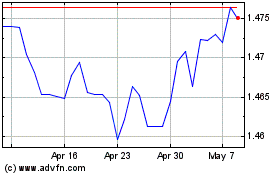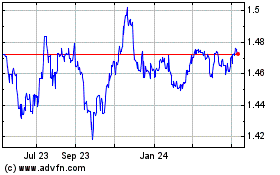Commodity Currencies Drop As Asian Stock Markets Fall On Geopolitical Tensions
August 08 2017 - 9:42PM
RTTF2
Commodity currencies such as the Australian, the New Zealand,
and the Canadian dollars weakened against their major counterparts
in the Asian session on Wednesday, as Asian stock markets traded
lower amid worries about rising tensions between the U.S. and North
Korea after President Donald Trump warned that further threats from
North Korea would be met with fire and fury.
In response, North Korea said it was carefully examining a plan
to strike the U.S.-held Pacific island of Guam with missiles.
Meanwhile, the crude oil delivery for September is currently
down 0.14 percent or $ 49.03 per barrel. The crude oil price fell
as OPEC gathered to discuss its supply quota plan. Analysts say the
cartel may announce deeper production cuts in order to sustain
above $50 a barrel.
Saudi Arabia will cut crude oil allocations to its customers
worldwide in September by at least 520,000 barrels per day, Reuters
reported.
In other economic news, data from Westpac showed that Australia
consumer confidence deteriorated further in August. The Westpac
Melbourne Institute Index of Consumer Sentiment dropped to 95.5 in
August from 96.6 in July.
Data from the Australian Bureau of Statistics showed that the
total number of home loans issued in Australia was up a seasonally
adjusted 0.5 percent in June, coming in at 54,404. That missed
forecasts for a gain of 1.5 percent following the 1.0 percent gain
in May.
Data from the National Bureau of Statistics showed that the
consumer prices in China were up 1.4 percent on year in July. That
was shy of expectations for 1.5 percent, which would have been
unchanged from the June reading.
On a monthly basis, inflation added 0.1 percent after slipping
0.2 percent in the previous month.
The bureau also said that producer prices advanced an annual 5.5
percent, missing forecasts of 5.6 percent which also would have
been unchanged.
In the Asian trading, the Australian dollar fell to a 5-day low
of 1.4938 against the euro and nearly a 5-week low of 86.29 against
the yen, from yesterday's closing of 1.4851 and 87.30,
respectively. If the aussie extends its downtrend, it may find
support around 1.51 against the euro and 85.00 against the yen.
Against the U.S. and the Canadian dollars, the aussie dropped to
more than a 3-week low of 0.7855 and a 6-day low of 0.9972 from
yesterday's closing quotes of 0.7911 and 1.0021, respectively. The
aussie may test support near 0.77 against the greenback and 0.98
against the loonie.
The aussie edged down to 1.0746 against the NZ dollar, from
yesterday's closing value of 1.0796. On the downside, 1.06 is seen
as the next support level for the aussie.
The NZ dollar fell to more than a 3-week low of 0.7308 against
the U.S. dollar and nearly a 2-month low of 80.23 against the yen,
from yesterday's closing quotes of 0.7328 and 80.84, respectively.
If the kiwi extends its downtrend, it is likely to find support
around 0.71 against the greenback and 78.00 against the yen.
Against the euro, the kiwi dropped to 1.6065 from yesterday's
closing value of 1.6037. The kiwi may test support near the 1.61
region.
The Canadian dollar fell to more than a 5-week low of 86.44
against the yen, from yesterday's closing value of 87.10. The
loonie may test support near the 85.00 region.
Against the euro and the U.S. dollar, the loonie dropped to
1.2698 and 1.4909 from yesterday's closing quotes of 1.2664 and
1.4875, respectively. If the loonie extends its downtrend, it is
likely to find support around 1.29 against the greenback, and 1.50
against the euro.
Looking ahead, Canada housing starts for July and building
permits for June, U.S. wholesale inventories for June, and U.S
crude oil inventories data are due to be released later in the New
York session.
Euro vs CAD (FX:EURCAD)
Forex Chart
From Mar 2024 to Apr 2024

Euro vs CAD (FX:EURCAD)
Forex Chart
From Apr 2023 to Apr 2024
